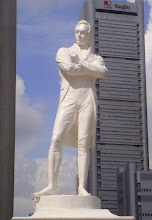For the first Sunday and Monday that month, as thousands flock to the banks of the Siem Reap river, Cambodia’s favourite form of tourist transportation suffers a shortage. For those days at least locals happily embrace capitalism’s theory of supply and demand, and a trip into the city centre inflates 100 percent, from US$1 to US$2!
 The yearly Cambodian Water Festival (variously spelled in the original Khmer as Bon Om Touk, or Bon Om Thook, or Bonn Om Teuk, or Bon Om Tuk) takes place on the full moon of the Buddhist month of Kadeuk. This is either October or, more usually, November. The festival celebrates the reversing flow between the the country’s great lake, Tonle Sap, and the mighty Mekong River.
The yearly Cambodian Water Festival (variously spelled in the original Khmer as Bon Om Touk, or Bon Om Thook, or Bonn Om Teuk, or Bon Om Tuk) takes place on the full moon of the Buddhist month of Kadeuk. This is either October or, more usually, November. The festival celebrates the reversing flow between the the country’s great lake, Tonle Sap, and the mighty Mekong River. The origins of the Water Festival dates back to the navy of King Jayavarman II, the 9th century founder of the “great” Angkorian Empire, with the main purpose to make the god of the river happy, thus hoping he will bestow much fish and rice on Cambodians.
The origins of the Water Festival dates back to the navy of King Jayavarman II, the 9th century founder of the “great” Angkorian Empire, with the main purpose to make the god of the river happy, thus hoping he will bestow much fish and rice on Cambodians.For most of the year, the Tonle Sap empties into the Mekong River. However, when the rainy season arrives in June, the Mekong rises, reversing the flow to dump water into the lake, increasing its size ten-fold. When the rainy season ends in November, the Mekong drops once more, allowing the current to reverse again, emptying the excess waters of Tonle Sap back into the Mekong.
 In Siem Reap the festival is held over two days, unlike the capital Phnom Penh where it is three. This allows Siem Reap’s champion a chance to head to the countries capital and vie for the national championship, an honour a team from the city took home in 2008.
In Siem Reap the festival is held over two days, unlike the capital Phnom Penh where it is three. This allows Siem Reap’s champion a chance to head to the countries capital and vie for the national championship, an honour a team from the city took home in 2008.The colours are amazing as the canoes, and crew, decked in the insignia of their team. Crews comprise about 40 rowers, all resplendent in their livery.
 The streets, seemingly never busy, are thronged with revellers dancing, eating and generally having a great time.
The streets, seemingly never busy, are thronged with revellers dancing, eating and generally having a great time.The footpaths are filled with hawker food. Some, like the French bread and pate rolls, a regular found in Indochina, looks delicious. The same can not be said for some of the fried insects, and what looks like rotting Yong Tau Foo, which has spent way ftoo long in the sun.
 I stick to the Baguette and pate.
I stick to the Baguette and pate.Edging my way to the front of the river bank, in order to take some pics, somehow a gap miraculously opens up in front, perhaps the only one left on the shores edge. I get as comfortable as a can.
Within minutes Dara, who is sitting with his wife, starts chatting to me, explaining that everyone has their favourite team and, like anywhere in the world, there would be a few bets placed on the races.
 A soon as the first heat starts a murmur goes up around me. This grows increasingly louder as the participants approach.
A soon as the first heat starts a murmur goes up around me. This grows increasingly louder as the participants approach. It’s interesting to watch the rowers. Some, who have obviously been practicing for months, and their faces are twisted in concentration; their bodies are racked with effort and, in some cases, what looks like pain. Others appear to be out for a bit of fun in the sun, relaxed and smiling.
 An audible roar goes up as the combatants pass us and necks are strained to see who ends the race victorious. Cheers and boos echo the results.
An audible roar goes up as the combatants pass us and necks are strained to see who ends the race victorious. Cheers and boos echo the results.Getting home after, well I decide to walk, the streets are packed and do I really want to haggle with a tuk tuk driver again?
 Cheers,
Cheers,Blocka






